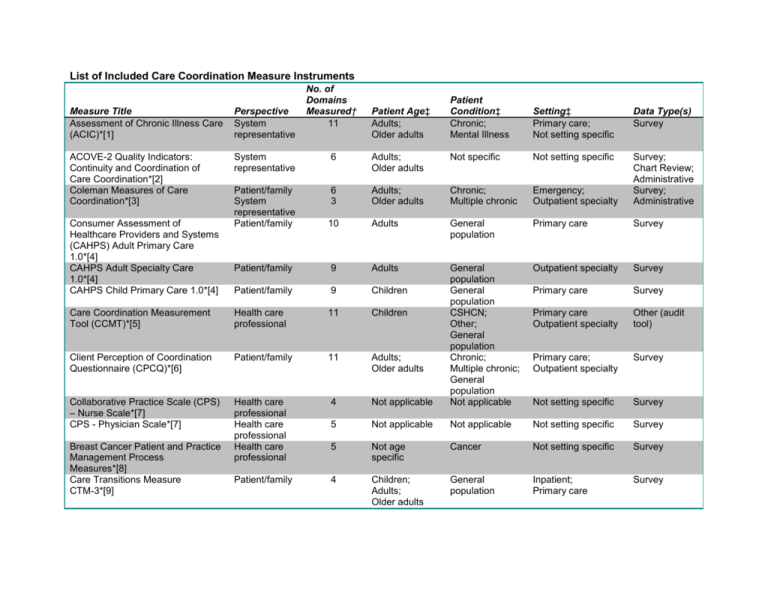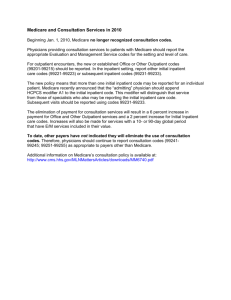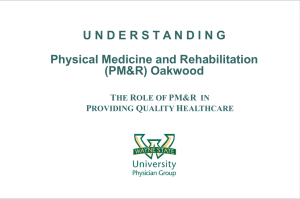List of Included Care Coordination Measure Instruments Measure
advertisement

List of Included Care Coordination Measure Instruments No. of Domains Measured† 11 Patient Condition‡ Chronic; Mental Illness Setting‡ Primary care; Not setting specific Data Type(s) Survey Adults; Older adults Not specific Not setting specific 6 3 Adults; Older adults Chronic; Multiple chronic Emergency; Outpatient specialty Survey; Chart Review; Administrative Survey; Administrative 10 Adults General population Primary care Survey Patient/family 9 Adults Outpatient specialty Survey Patient/family 9 Children Primary care Survey Care Coordination Measurement Tool (CCMT)*[5] Health care professional 11 Children Primary care Outpatient specialty Other (audit tool) Client Perception of Coordination Questionnaire (CPCQ)*[6] Patient/family 11 Adults; Older adults Primary care; Outpatient specialty Survey Collaborative Practice Scale (CPS) – Nurse Scale*[7] CPS - Physician Scale*[7] Health care professional Health care professional Health care professional 4 Not applicable General population General population CSHCN; Other; General population Chronic; Multiple chronic; General population Not applicable Not setting specific Survey 5 Not applicable Not applicable Not setting specific Survey 5 Not age specific Cancer Not setting specific Survey Patient/family 4 Children; Adults; Older adults General population Inpatient; Primary care Survey Measure Title Assessment of Chronic Illness Care (ACIC)*[1] Perspective System representative ACOVE-2 Quality Indicators: Continuity and Coordination of Care Coordination*[2] Coleman Measures of Care Coordination*[3] System representative 6 Patient/family System representative Patient/family Consumer Assessment of Healthcare Providers and Systems (CAHPS) Adult Primary Care 1.0*[4] CAHPS Adult Specialty Care 1.0*[4] CAHPS Child Primary Care 1.0*[4] Breast Cancer Patient and Practice Management Process Measures*[8] Care Transitions Measure CTM-3*[9] Patient Age‡ Adults; Older adults Measure Title Care Transitions Measure CTM-15*[10] Perspective Patient/family No. of Domains Measured† 9 Patient Assessment of Care for Chronic Conditions (PACIC)*[11] Family-Centered Care SelfAssessment Tool – Family Version*[12] Family-Centered Care SelfAssessment Tool – Provider Version*[12] ICU Nurse-Physician Questionnaire – Long Version*[13] ICU Nurse-Physician Questionnaire – Short Version*[13] Primary Care Assessment Survey (PCAS)*[14] National Survey of Children With Special Health Care Needs (CSHCN)*[15] Head And Neck Cancer Integrated Care Indicators*[16] Medical Home Index (MHI) – Long version*[17] Patient/family 9 Adults Patient/family 13 Children Chronic; Multiple chronic CSHCN Health care professional 13 Children Health care professional Health care professional Patient/family 8 Patient/family System representative System representative MHI - Short Version*[18] Medical Home Family Index and Survey (MHFIS)*[19] Primary Care Assessment Tool (PCAT) – Child Expanded Edition*[20] PCAT - Adult Expanded Edition*[21] PCAT - Facility Expanded Edition*[22] Patient Age‡ Adults Patient Condition‡ General population Setting‡ Inpatient; Primary care; Home health Primary care Data Type(s) Survey Not setting specific Survey CSHCN Not setting specific Survey Not applicable Not applicable Inpatient Survey 6 Not applicable Not applicable Inpatient Survey 8 General population CSHCN Primary care Survey 9 Adults; Older adults Children Not setting specific Survey 4 Adults Cancer Inpatient 13 Children; Adults Primary care System representative 8 Children; Adults Primary care Survey Patient/family 14 Children CSHCN; General population CSHCN; General population CSHCN Survey Chart Review Survey Primary care Survey Patient/family 11 Children General population Primary care Survey Patient/family 11 Adults Primary care Survey System representative 12 Not applicable General population Not applicable Primary care Survey Survey Measure Title PCAT - Provider Expanded Edition*[22] Physician-Pharmacist Collaboration Instrument (PPCI)*[23] Perspective Health care professional Health care professional Patient-Centered Medical Home (PCMH) Survey of Structural Capabilities of Primary Care Practice Sites*[24] Family Medicine Medication Use Processes Matrix (MUPM)*[25] Resources and Support for SelfManagement (RSSM)*[26] Continuity of Care Practices Survey – Program Level*[27] CCPS - Individual Level*[27] No. of Domains Measured† 12 Patient Age‡ Not applicable Patient Condition‡ Not applicable Setting‡ Primary care Data Type(s) Survey Primary care; Not specific Survey Primary care Survey 5 Not specific System representative 5 Not applicable Chronic; General population Not applicable Health care professional Patient/family 7 Not applicable Not applicable Primary care Survey 10 Not specific Chronic Primary care Survey System representative Health care professional Health care professional 10 Adult Mental illness Behavioral health Survey 11 Adult Mental illness Behavioral health Survey 6 Adult; Older adult General population LTC Survey Patient/family 9 Children Other Survey Patient/family 5 Not specific Inpatient Survey Patient/family 7 Adult Inpatient; Not specific Survey Health care professional 7 Children CSHCN; Other Cancer; End-of-life Cancer; General population General population Survey Collaboration and Satisfaction About Care Decisions (CSACD)*[33] Follow Up Care Delivery*[34] Health care professional 2 Not applicable Not applicable Inpatient; Primary care; Outpatient specialty Inpatient Patient/family 5 Cancer Patient/family 4 Primary care; Outpatient specialty Inpatient Survey Family Satisfaction in the Intensive Care Unit (FS-ICU 24)*[35] Adults; Older adults Adults Nursing Home Work Environment and Performance Team Survey*[28] Measure of Processes of Care (MPOC-28)*[29] Care Evaluation Scale for End-ofLife Care (CES)*[30] Oncology Patients’ Perceptions of the Quality of Nursing Care Scale (OPPQNCS)*[31] Care Coordination Services In Pediatric Practices*[32] General population Survey Survey Measure Title Korean Primary Care Assessment Tool (KPCAT)*[36] Primary Care Multimorbidity Hassles for Veterans With Chronic Illnesses*[37] Primary Care Satisfaction Survey for Women (PCSSW)*[38] Personal Health Records (PHR)*[39] Picker Patient Experience (PPE15)*[40] Physician Office Quality of Care Monitor (QCM)*[41] Patient Perceptions of Care (PPOC)*[42] Perspective Patient/family No. of Domains Measured† 8 Patient/family 8 Adults Patient/family 7 Adults System representative Patient/family 4 Not applicable 6 Adults Patient/family 6 Not specific Patient/family 10 Adults PREPARED Survey – Patient version*[43] PREPARED Survey – Carer Version[43] PREPARED Survey – Residential Care Staff Version*[44] Patient/family 9 Patient/family 8 Health care professional 4 Adults; Older adults Adults; Older adults Adults; Older adults General population General population General population PREPARED Survey – Community Service Provider Version*[44] Health care professional 6 Adults; Older adults General population PREPARED Survey – Medical Practitioner Version*[43] PREPARED Survey – Modified Medical Practitioner Version*[45] Health Tracking Household Survey*[46] Health care professional Health care professional Patient/family 10 7 Adults; Older adults Adults 4 Adults Adapted Picker Institute Cancer Survey*[47] Ambulatory Care Experiences Survey (ACES)*[48] Patient/family 9 Adults General population General population Chronic; General population Cancer Patient/family 5 Children; Adults General population Patient Age‡ Not specific Patient Condition‡ General population Chronic; Multiple chronic; Mental illness General population Not applicable General population General population General population Setting‡ Primary care Data Type(s) Survey Primary care Survey Primary care Survey Not specific Survey Inpatient Survey Primary care; Outpatient specialty Primary care; Outpatient specialty; Behavioral health Inpatient; Primary care Inpatient; Primary care Inpatient; Primary care; LTC Inpatient; LTC; Not specific Inpatient; Primary care Inpatient; Primary care Primary care; Outpatient specialty Survey Inpatient Survey Primary care Survey Survey Survey Survey Survey Survey Survey Survey Survey No. of Domains Measured† 6 Patient Age‡ Adults Health care professional 6 Not applicable Patient Condition‡ General population Not applicable Measure Title Patient Perception of Continuity Instrument (PC)*[49] Jefferson Survey of Attitudes Toward Physician-Nurse Collaboration*[50] Clinical Microsystem Assessment Tool (CMAT)*[51] Components of Primary Care Index (CPCI)*[52] Perspective Patient/family System representative Patient/family 6 Not applicable 7 Relational Coordination Survey*[53] Health care professional 4 Children; Adults; Not specific Adults; Older adults; Not specific Fragmentation of Care Index (FCI)*[54] After-Death Bereaved Family Member Interview*[55] System representative Patient/family 1 Adults 5 Adults; Older adults Schizophrenia Quality Indicators for Integrated Care*[56] Patient/family System representative System representative Patient/family 1 8 Not specific Mental illness 3 Not specific Not specific 7 Children System representative 6 Adults General population General population Chronic; Multiple chronic; Mental illness Primary care; Behavioral health Survey System representative 1 Adults; Not specific Chronic; Other Inpatient; Outpatient specialty Chart review Administrative System representative 2 Adults; Not specific Chronic; Other Outpatient specialty; Not specific Chart review Administrative Degree of Clinical Integration Measures*[57] National Survey for Children’s Health (NSCH)*[58] Mental Health Professional HIV/AIDS Point Prevalence and Treatment Experiences Survey Part II*[59] Cardiac Rehabilitation Patient Referral from an Inpatient Setting*[60] Cardiac Rehabilitation Patient Referral from an Outpatient Setting*[60] Setting‡ Primary care Data Type(s) Survey Not specific Survey Not applicable Not specific Survey General population Primary care; Outpatient specialty Survey Chronic; Multiple chronic; Other; General population Chronic; Multiple chronic End-of-Life Inpatient; Primary care; Outpatient specialty; LTC Survey Primary care; Outpatient specialty Inpatient; LTC; Home health Not specific Chart review Not specific Survey Survey Chart review Administrative Chart review Administrative Survey Measure Title Patients with a Transient Ischemic Event ER Visit That Had a Follow Up Office Visit*[61] Biopsy Follow Up*[61] Reconciled Medication List Received by Discharged Patients*[62] Transition Record with Specified Elements Received by Discharged Patients (Inpatient Discharges)*[62] Timely Transmission of Transition Record*[62] Transition Record with Specified Elements Received by Discharged Patients (Emergency Department Discharges)*[62] Melanoma Continuity of Care— Recall System*[63] Team Survey for Program of Allinclusive Care for the Elderly (PACE)[64] Patient Experiences with Cancer Care Survey[65] Parents' Attitudes Towards Communication of Physicians and Complementary and Alternative Medicine (CAM) Practitioners[66] Multiple Sclerosis Quality Indicators[67] Integrated Healthcare Model Study 2: Primary Care Provider Questionnaire[68] Perspective System representative No. of Domains Measured† 2 Patient Age‡ Adults Patient Condition‡ Other System representative System representative 1 Not specific Other 4 Not specific General population System representative 6 Not specific General population System representative 5 Not specific General population System representative 6 Not specific General population System representative Health care professional 1 Not specific Cancer Setting‡ Emergency; Primary care; Outpatient specialty Primary care; Not specific Inpatient; Primary care; Not specific Inpatient; Primary care; Not specific Inpatient; Primary care; Not specific Emergency; Primary care; Outpatient specialty; Home health Not specific Data Type(s) Administrative 5 Adults; Older adults General population Primary care; Outpatient specialty Patient/family 4 Adults Cancer Not specific Survey Patient/family 8 Children General population Primary care; Outpatient specialty Survey Patient/family System representative Health care professional 1 6 Not specific Chronic Not specific 6 Not specific Mental illness Primary care; Behavioral health Survey Chart review Administrative Survey Chart review Administrative Chart review Administrative Chart review Administrative Chart review Administrative Chart review Administrative Chart review Administrative Survey Measure Title Integrated Healthcare Model Study 2: Behavioral Healthcare Provider Questionnaire[68] Breast Cancer Patients' Perceptions of Care Coordination[69] Medical Care Questionnaire (MCQ)[70] Community Mental Health Teams for Older People (CMHTsOP) Team Integration Indicators[71] The Joint Commission PatientCentered Medical Home Selfassessment Survey Collaborative Care for AttentionDeficit Disorder Scale (CCADDS)[73] Follow-up Coordination Survey[74] CAHPS Patient-Centered Medical Home Supplementary Survey[75] Parents' Perceptions of Primary Care (P3C)[76] Patient Satisfaction with Cancerrelated Care (PSCC)[77] Primary Care Questionnaire for Complex Pediatric Patients[78] Dementia Guideline-Derived Quality of Care Indicators[79] Perspective Health care professional No. of Domains Measured† 9 Patient Age‡ Not specific Patient Condition‡ Mental illness Setting‡ Primary care; Behavioral health Data Type(s) Survey Patient/family 5 Adults Cancer Not specific Survey Patient/family 2 Not specific Cancer Outpatient specialty Survey Health care professional 4 Adults; Older adults Mental illness Behavioral health Survey System representative 15 Not specific General population Primary care; Outpatient specialty Survey Health care professional 10 Children CSHCN Primary care Survey Health care professional Patient/family 3 Children Primary care 3 Survey Chart review Survey Patient/family 5 Children; Adults Children Patient/family 4 Adults General population General population General population Cancer Not specific Survey Patient/family System representative Patient/family System representative Patient/family 7 11 Children CSHCN Primary care Survey Chart review 5 3 Adults; Older adults Other Not specific Survey Chart review Primary care; Outpatient specialty Primary care Survey Canadian Survey of Experiences 11 Not specific General Primary care Survey with Primary Health Care population Questionnaire[80] *Further details of this measure, including the domains to which it maps, are included in the measure profile within the Care Coordination Measures Atlas [81] †When more than one perspective is measured by a single instrument, the number of domains measured is reported separately for each perspective. ‡Characterization based on measure intent or any known use. Some measures have been used in multiple studies, and therefore may be mapped to more than one specific category in addition to a non-specific category. CSHCN – Children with special health care needs; LTC – Long-term care References 1. Bonomi AE, Wagner EH, Glasgow RE, VonKorff M: Assessment of chronic illness care (ACIC): a practical tool to measure quality improvement. Health Serv Res 2002, 37(3):791-820. 2. Wenger NS, Young RT: Quality indicators for continuity and coordination of care in vulnerable elders. J Am Geriatr Soc 2007, 55 Suppl 2:S285-292. 3. Coleman EA, Eilertsen TB, Magid DJ, Conner DA, Beck A, Kramer AM: The association between care co-ordination and emergency department use in older managed care enrollees. Int J Integr Care 2002, 2:e03. 4. CAHPS Surveys and Tools [https://www.cahps.ahrq.gov/default.asp] 5. Antonelli RC, Antonelli DM: Providing a medical home: the cost of care coordination services in a community-based, general pediatric practice. Pediatrics 2004, 113(5 Suppl):1522-1528. 6. McGuiness C, Sibthorpe B: Development and initial validation of a measure of coordination of health care. Int J Qual Health Care 2003, 15(4):309-318. 7. Weiss SJ, Davis HP: Validity and reliability of the Collaborative Practice Scales. Nurs Res 1985, 34(5):299-305. 8. Katz SJ, Hawley ST, Morrow M, Griggs JJ, Jagsi R, Hamilton AS, Graff JJ, Friese CR, Hofer TP: Coordinating cancer care: patient and practice management processes among surgeons who treat breast cancer. Med Care 2010, 48(1):45-51. 9. Parry C, Mahoney E, Chalmers SA, Coleman EA: Assessing the quality of transitional care: further applications of the care transitions measure. Med Care 2008, 46(3):317-322. 10. Coleman EA, Smith JD, Frank JC, Eilertsen TB, Thiare JN, Kramer AM: Development and testing of a measure designed to assess the quality of care transitions. Int J Integr Care 2002, 2:e02. 11. Glasgow RE, Wagner EH, Schaefer J, Mahoney LD, Reid RJ, Greene SM: Development and validation of the Patient Assessment of Chronic Illness Care (PACIC). Med Care 2005, 43(5):436-444. 12. Family Centered Care Self-Assessment Tool - Family Version. October 2008. [http://www.familyvoices.org/pub/index.php?topic=fcc] 13. Shortell SM, Rousseau DM, Gillies RR, Devers KJ, Simons TL: Organizational assessment in intensive care units (ICUs): construct development, reliability, and validity of the ICU nurse-physician questionnaire. Med Care 1991, 29(8):709-726. 14. Safran DG, Kosinski M, Tarlov AR, Rogers WH, Taira DH, Lieberman N, Ware JE: The Primary Care Assessment Survey: tests of data quality and measurement performance. Med Care 1998, 36(5):728-739. 15. 16. 17. 18. 19. 20. 21. 22. 23. 24. 25. 26. 27. 28. 29. 30. 31. Blumberg SJ, Welch EM, Chowdhury SR, Upchurch HL, Parker EK, Skalland BJ: Design and operation of the National Survey of Children with Special Health Care Needs, 2005-2006. Vital and health statistics Ser 1, Programs and collection procedures 2008(45):1188. Ouwens MM, Marres HA, Hermens RR, Hulscher MM, van den Hoogen FJ, Grol RP, Wollersheim HC: Quality of integrated care for patients with head and neck cancer: Development and measurement of clinical indicators. Head & neck 2007, 29(4):378-386. Cooley WC, McAllister JW, Sherrieb K, Clark RE: The Medical Home Index: Development and validation of a new practice-level measure of implementation of the Medical Home model. Ambulatory Pediatrics 2003, 3(4):173-180. Center for Medical Home Improvement [http://www.medicalhomeimprovement.org/knowledge/practices.html#measurement] McAllister JW, Sherrieb K, Cooley WC: Improvement in the Family-Centered Medical Home Enhances Outcomes for Children and Youth with Special Healthcare Needs. Journal of Ambulatory Care Management 2009, 32(3):188-196. Cassady CE, Starfield B, Hurtado MP, Berk RA, Nanda JP, Friedenberg LA: Measuring consumer experiences with primary care. Pediatrics 2000, 105(4):998-1003. Shi L: Validating the Adult Primary Care Assessment Tool. J Fam Pract 2001, 50:161. Johns Hopkins University Bloomberg School of Public Health Primary Care Assessment Tools [http://www.jhsph.edu/pcpc/pca_tools.html] Zillich AJ, Doucette WR, Carter BL, Kreiter CD: Development and initial validation of an instrument to measure physicianpharmacist collaboration from the physician perspective. Value in health : the journal of the International Society for Pharmacoeconomics and Outcomes Research 2005, 8(1):59-66. Friedberg MW, Safran DG, Coltin KL, Dresser M, Schneider EC: Readiness for the Patient-Centered Medical Home: structural capabilities of Massachusetts primary care practices. J Gen Intern Med 2009, 24(2):162-169. Farrell B, Pottie K, Woodend K, Yao VH, Kennie N, Sellors C, Martin C, Dolovich L: Developing a tool to measure contributions to medication-related processes in family practice. Journal of interprofessional care 2008, 22(1):17-29. McCormack LA, Williams-Piehota PA, Bann CM, Burton J, Kamerow DB, Squire C, Fisher E, Brownson CA, Glasgow RE: Development and validation of an instrument to measure resources and support for chronic illness self-management: a model using diabetes. Diabetes Educ 2008, 34(4):707-718. Schaefer JA, Cronkite R, Ingudomnukul E: Assessing continuity of care practices in substance use disorder treatment programs. Journal of studies on alcohol 2004, 65(4):513-520. Temkin-Greener H, Zheng N, Katz P, Zhao H, Mukamel DB: Measuring work environment and performance in nursing homes. Med Care 2009, 47(4):482-491. Granat T, Lagander B, Borjesson MC: Parental participation in the habilitation process--evaluation from a user perspective. Child Care Health Dev 2002, 28(6):459-467. Morita T, Hirai K, Sakaguchi Y, Maeyama E, Tsuneto S, Shima Y: Measuring the quality of structure and process in end-of-life care from the bereaved family perspective. J Pain Symptom Manage 2004, 27(6):492-501. Radwin LE, Cabral HJ, Wilkes G: Relationships between patient-centered cancer nursing interventions and desired health outcomes in the context of the health care system. Res Nurs Health 2009, 32(1):4-17. 32. 33. 34. 35. 36. 37. 38. 39. 40. 41. 42. 43. 44. 45. 46. 47. 48. Gupta G, Unruh ML, Nolin TD, Hasley PB: Primary care of the renal transplant patient. Journal of General Internal Medicine 2010, 25(7):731-740. Baggs JG: Development of an instrument to measure collaboration and satisfaction about care decisions. J Adv Nurs 1994, 20(1):176-182. Haggstrom DA, Arora NK, Helft P, Clayman ML, Oakley-Girvan I: Follow-up care delivery among colorectal cancer survivors most often seen by primary and subspecialty care physicians. J Gen Intern Med 2009, 24 Suppl 2:S472-479. Stricker KH, Kimberger O, Schmidlin K, Zwahlen M, Mohr U, Rothen HU: Family satisfaction in the intensive care unit: what makes the difference? Intensive Care Med 2009, 35(12):2051-2059. Lee JH, Choi YJ, Sung NJ, Kim SY, Chung SH, Kim J, Jeon TH, Park HK, Korean Primary Care Research G: Development of the Korean primary care assessment tool--measuring user experience: tests of data quality and measurement performance. Int J Qual Health Care 2009, 21(2):103-111. Parchman ML, Noel PH, Lee S: Primary care attributes, health care system hassles, and chronic illness. Med Care 2005, 43(11):1123-1129. Scholle SH, Weisman CS, Anderson RT, Camacho F: The development and validation of the primary care satisfaction survey for women. Womens Health Issues 2004, 14(2):35-50. Reti SR, Feldman HJ, Ross SE, Safran C: Improving personal health records for patient-centered care. J Am Med Inform Assoc 2010, 17(2):192-195. Jenkinson C, Coulter A, Bruster S: The Picker Patient Experience Questionnaire: development and validation using data from inpatient surveys in five countries. Int J Qual Health Care 2002, 14(5):353-358. Seibert JH, Strohmeyer JM, Carey RG: Evaluating the physician office visit: in pursuit of a valid and reliable measure of quality improvement efforts. The Journal of ambulatory care management 1996, 19(1):17-37. Borowsky SJ, Nelson DB, Fortney JC, Hedeen AN, Bradley JL, Chapko MK: VA community-based outpatient clinics: performance measures based on patient perceptions of care. Med Care 2002, 40(7):578-586. Grimmer K, Moss J: The development, validity and application of a new instrument to assess the quality of discharge planning activities from the community perspective. Int J Qual Health Care 2001, 13(2):109-116. International Centre for Allied Health Evidence [http://www.unisa.edu.au/cahe/Resources/DCP/Information.asp] Graumlich JF, Grimmer-Somers K, Aldag JC: Discharge planning scale: community physicians' perspective. J Hosp Med 2008, 3(6):455-464. O'Malley AS, Cunningham PJ: Patient experiences with coordination of care: the benefit of continuity and primary care physician as referral source. J Gen Intern Med 2009, 24(2):170-177. Ayanian JZ, Zaslavsky AM, Guadagnoli E, Fuchs CS, Yost KJ, Creech CM, Cress RD, O'Connor LC, West DW, Wright WE: Patients' perceptions of quality of care for colorectal cancer by race, ethnicity, and language. Journal of clinical oncology : official journal of the American Society of Clinical Oncology 2005, 23(27):6576-6586. Safran DG, Karp M, Coltin K, Chang H, Li A, Ogren J, Rogers WH: Measuring patients' experiences with individual primary care physicians. Results of a statewide demonstration project. J Gen Intern Med 2006, 21(1):13-21. 49. 50. 51. 52. 53. 54. 55. 56. 57. 58. 59. 60. 61. 62. Chao J: Continuity of care: incorporating patient perceptions. Fam Med 1988, 20(5):333-337. Hojat M, Fields SK, Veloski JJ, Griffiths M, Cohen MJ, Plumb JD: Psychometric properties of an attitude scale measuring physiciannurse collaboration. Evaluation & the health professions 1999, 22(2):208-220. Intitute for Healthcare Improvement [http://www.ihi.org/IHI/Topics/Improvement/ImprovementMethods/Tools/ClinicalMicrosystemAssessmentTool.htm] Flocke SA: Measuring attributes of primary care: development of a new instrument. J Fam Pract 1997, 45(1):64-74. Gittell JH, Fairfield KM, Bierbaum B, Head W, Jackson R, Kelly M, Laskin R, Lipson S, Siliski J, Thornhill T et al: Impact of relational coordination on quality of care, postoperative pain and functioning, and length of stay: a nine-hospital study of surgical patients. Med Care 2000, 38(8):807-819. Liu CW, Einstadter D, Cebul RD: Care fragmentation and emergency department use among complex patients with diabetes. Am J Manag Care 2010, 16(6):413-420. Teno JM, Clarridge B, Casey V, Edgman-Levitan S, Fowler J: Validation of Toolkit After-Death Bereaved Family Member Interview. J Pain Symptom Manage 2001, 22(3):752-758. Weinmann S, Roick C, Martin L, Willich S, Becker T: Development of a set of schizophrenia quality indicators for integrated care. Epidemiologia e psichiatria sociale 2010, 19(1):52-62. Devers KJ, Shortell SM, Gillies RR, Anderson DA, Mitchell JB, Erickson KL: Implementing organized delivery systems: an integration scorecard. Health Care Manage Rev 1994, 19(3):7-20. National Survey of Children's Health Data Resource Center for Child and Adolescent Health [http://www.nschdata.org/content/Default.aspx] Lemmon R, Shuff IM: Effects of mental health centre staff turnover on HIV/AIDS service delivery integration. AIDS care 2001, 13(5):651-661. American Association of Cardiovascular and Pulmonary Rehabilitation, American College of Cardiology Foundation, American Heart Association Task Force on Performance Measures, Thomas RJ, King M, Lui K, Oldridge N, Pina IL, Spertus J: AACVPR/ACCF/AHA 2010 Update: Performance Measures on Cardiac Rehabilitation for Referral to Cardiac Rehabilitation/Secondary Prevention Services Endorsed by the American College of Chest Physicians, the American College of Sports Medicine, the American Physical Therapy Association, the Canadian Association of Cardiac Rehabilitation, the Clinical Exercise Physiology Association, the European Association for Cardiovascular Prevention and Rehabilitation, the Inter-American Heart Foundation, the National Association of Clinical Nurse Specialists, the Preventive Cardiovascular Nurses Association, and the Society of Thoracic Surgeons. Journal of the American College of Cardiology 2010, 56(14):1159-1167. National Quality Forum: Preferred Practices and Performance Measures for Measuring and Reporting Care Coordination: A Consensus Report. Washington, DC: National Quality Forum; 2010. American Board of Internal Medicine Foundation, American College of Physicians, Society of Hospital Medicine, Physician Consortium for Performance Improvement: Care Transitions Performance Measurement Set (Phase I: Inpatient discharges and emergency department discharges). Chicago, IL: American Medical Association; 2009. 63. 64. 65. 66. 67. 68. 69. 70. 71. 72. 73. 74. 75. 76. American Academy of Dermatology, Physician Consortium for Performance Improvement, National Committee for Quality Assurance: Melanoma II Physician Performance Measurement Set. Chicago, IL and Washington, D.C.: American Medical Association and National Committee for Quality Assurance; 2007. Temkin-Greener H, Gross D, Kunitz SJ, Mukamel D: Measuring interdisciplinary team performance in a long-term care setting. Med Care 2004, 42(5):472-481. Ayanian JZ, Zaslavsky AM, Arora NK, Kahn KL, Malin JL, Ganz PA, van Ryn M, Hornbrook MC, Kiefe CI, He Y et al: Patients' experiences with care for lung cancer and colorectal cancer: findings from the Cancer Care Outcomes Research and Surveillance Consortium. Journal of clinical oncology : official journal of the American Society of Clinical Oncology 2010, 28(27):41544161. Ben-Arye E, Traube Z, Schachter L, Haimi M, Levy M, Schiff E, Lev E: Integrative pediatric care: parents' attitudes toward communication of physicians and CAM practitioners. Pediatrics 2011, 127(1):e84-95. Cheng EM, Crandall CJ, Bever CT, Jr., Giesser B, Haselkorn JK, Hays RD, Shekelle P, Vickrey BG: Quality indicators for multiple sclerosis. Multiple sclerosis 2010, 16(8):970-980. Funderburk JS, Sugarman DE, Maisto SA, Ouimette P, Schohn M, Lantinga L, Wray L, Batki S, Nelson B, Coolhart D et al: The description and evaluation of the implementation of an integrated healthcare model. Families, systems & health : the journal of collaborative family healthcare 2010, 28(2):146-160. Hawley ST, Janz NK, Lillie SE, Friese CR, Griggs JJ, Graff JJ, Hamilton AS, Jain S, Katz SJ: Perceptions of care coordination in a population-based sample of diverse breast cancer patients. Patient education and counseling 2010, 81 Suppl:S34-40. Velikova G, Keding A, Harley C, Cocks K, Booth L, Smith AB, Wright P, Selby PJ, Brown JM: Patients report improvements in continuity of care when quality of life assessments are used routinely in oncology practice: secondary outcomes of a randomised controlled trial. European journal of cancer 2010, 46(13):2381-2388. Wilberforce M, Harrington V, Brand C, Tucker S, Abendstern M, Challis D: Towards integrated community mental health teams for older people in England: progress and new insights. Int J Geriatr Psychiatry 2011, 26(3):221-228. The Joint Commission Patient-Centered Medical Home (PCMH) Self-Assessment Tool web site [http://www.jointcommission.org/joint_commission_primary_care_medical_home_self-assessment_tool___/] Guevara JP, Greenbaum PE, Shera D, Shea JA, Bauer L, Schwarz DF: Development and psychometric assessment of the collaborative care for attention-deficit disorders scale. Ambulatory pediatrics : the official journal of the Ambulatory Pediatric Association 2008, 8(1):18-24. Forrest CB, Glade GB, Starfield B, Baker AE, Kang M, Reid RJ: Gatekeeping and referral of children and adolescents to specialty care. Pediatrics 1999, 104(1 Pt 1):28-34. CAHPS Surveys and Tools to Advance Patient-Centered Care web site [https://www.cahps.ahrq.gov/SurveysGuidance/CG/PCMH.aspx] Seid M, Varni JW, Bermudez LO, Zivkovic M, Far MD, Nelson M, Kurtin PS: Parents' Perceptions of Primary Care: measuring parents' experiences of pediatric primary care quality. Pediatrics 2001, 108(2):264-270. 77. 78. 79. 80. 81. Jean-Pierre P, Fiscella K, Freund KM, Clark J, Darnell J, Holden A, Post D, Patierno SR, Winters PC, Patient Navigation Research Program G: Structural and reliability analysis of a patient satisfaction with cancer-related care measure: a multisite patient navigation research program study. Cancer 2011, 117(4):854-861. Chen AY, Schrager SM, Mangione-Smith R: Quality measures for primary care of complex pediatric patients. Pediatrics 2012, 129(3):433-445. Chodosh J, Pearson ML, Connor KI, Vassar SD, Kaisey M, Lee ML, Vickrey BG: A dementia care management intervention: which components improve quality? American Journal of Managed Care 2012, 18(2):85-94. Jesmin S, Thind A, Sarma S: Does team-based primary health care improve patients' perception of outcomes? Evidence from the 2007-08 Canadian Survey of Experiences with Primary Health. Health Policy 2012, 105(1):71-83. McDonald K, Schultz E, Albin L, Pineda N, Lonhart J, Sundaram V, Smith-Spangler C, Brustrum J, Malcolm E: Care Coordination Atlas Version 3 (Prepared by Stanford University under subcontract to Battelle on Contract No. 290-04-0020). Rockville, MD: Agency for Healthcare Research and Quality; November 2010.






